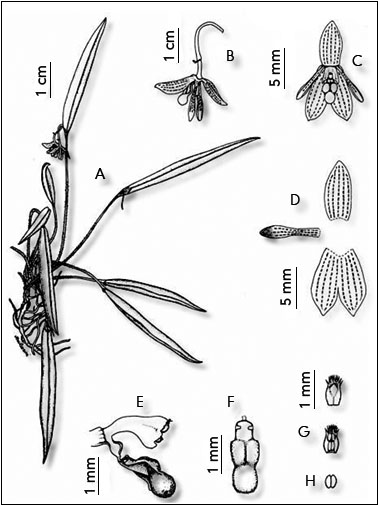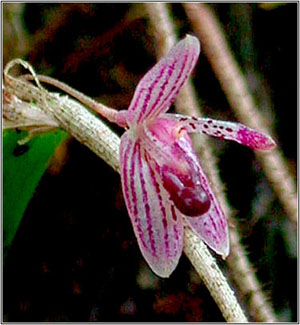Introduction
The genus Myoxanthus Poeppig & Endlicher had an agitating history.
Just after its description, in 1835, the species-type, Myoxanthus monophyllus
(Colombia, Ecuador, Peru) was transferred by Lindley to the genus
Pleurothallis R. Brown. Later, Karsten described a species under
the name of Duboisia reymondii (Colombia, Ecuador, Venezuela),
nowadays, Myoxanthus reymondii. Six years after, Reichenbach has
also transferred it to the genus Pleurothallis. In 1882, Barbosa
Rodrigues described a species under the name of Chaetocephala punctata
(nowadays Myoxanthus punctatus) which was transferred by Cogniaux
to Pleurothallis.
In fact, that was Carl Luer who, in 1982, in the context of his monumental
work on Pleurothallidinae, revived the genus gathering 38 known
species until then, to which at about ten species more recently discovered
have been added. They are typical inhabitants of tropical dense wood,
with a bipolar geographical distribution and most species are found between
Bolivia and Mexico with a small extension towards Venezuela and Guiana,
while a small group (8 species) is Brazilian. In Espírito Santo,
biological diversity pole, there are, nowadays, 5 registered species and
between them, Myoxanthus ruschii C.N. de Fraga & L.J.C. Kollmann,
described in 2003.
The discovery of a new species is not, in this way, a totally improbable
occurrence and this one has been discovered by Nelson Sanson, a very competent
amateur observer from Conceição do Castelo who tireless
travels all over the few forests that still resist in this municipality,
situated in lower part of the mountain of Espírito Santo. This
species can be distinguished from the others by its small size and, in
this particularly, it is comparable to Myoxanthus ruschii, but
it can be mainly distinguished from the other known species by the purple
color of its flowers, while the chestnut color, in the lack of white,
seems to be the rule of the genus.

Planta herbacea, epiphyta, in genere parva, Myoxanthus lonchophyllus,
punctatus vel seidelii affinis sed manifeste minor, folia maxime 10 cm
longa cum marginibus nervo medianoque atropurpureis, floribus fasciculatis
succedaneis nutantibus et lilaceis, labello 5,5 mm longo, 2 mm lato, antice
canaliculato, postice cum marginibus recurvatis,saccum sphaericum atropurpureum
nitensque formantibus, columna 3,5 mm longa, recta, pede mentum 1,5 mm
formante, rosacea 5-plo roseolineataque.
Type
: Brazil, Espírito Santo, Conceição do Castelo, Cachoeira
da Fumaça, latitude 20° 22’ 40’’ S, longitude
41° 15’ 00’’ W, 620 m altitude, July 2003 (flowers),
Nelson Sanson s.n. ex M. Frey 531 (Holotype: MBML, Isotype : M. Frey 531
: LY, the same plant).
Description
Herbaceous upright plant, epiphyte of wood, 15-18 (20) cm high. Cylindrical
rhizome, 3 mm diameter, slightly rampant (3-6 mm between ramicaul),
recovered by hispid sheaths; Brown yellowish roots, with until
10 cm long, and, at about, 1 mm de thick; upright ramicauls, 4-8
cm high, 1,2 mm thick, 4-articulate, recovered by imbricate sheaths garnished
by brown trichomas; upright leaf, coriaceous, 7-10 cm long, 9-10
mm wide, 2 mm thick, narrowly lanceolate, cuneiform base, acute extremity,
olive-green with purple margins and central nervures, glabrous, smooth
margins; inflorescence arising from a very small bract, formed by fasculate
succeeding flowers, in general one, sometimes, 2 at the same time; very
small bract, peduncle 12-15 mm long, filiform, pendent, glabrous, slightly
purple; pedicel 2 mm long; ovary 3 mm long and 0,6-0,8 mm diameter;
nutant flower, purple color in general; dorsal sepal
8 mm long, 3 mm width, egg shaped, convex, obtuse apex, glabrous, smooth
translucent light pink slightly recurved margins with 5 longitudinal dark
purple lines; oval convex lateral sepals fused until 2/3, 8 mm
long, 3 mm wide, rectangular apiculate apex, glabrous, smooth margins
in the same color as the dorsal; filiforme straight petals 8,5-9
mm, long, 1 mm wide, with an slightly enlarged base and thick light pink
translucent apex, with 3 longitudinal dark purple lines and recurved margins
towards the middle, purple apex; lip 5,5 mm long, 2 mm wide, first
caniculate than the margins are recurved to form a spherical brilliant
dark purple pouch caniculated, the lower part pinkish with dark purple
lines; straight column 3,5 mm long, 1,5 mm wide, forming a chin
of 1,5 mm, the lateral forming slightly prominent light-pink wings and
veined with 5 darker pink lines; yellow-sulphur anther. Seedrawing
1 and photography.

Fig. 1
: Myoxanthus conceiçoensis M. Frey & N. Sanson
A : plant – B & C : flower – D : floral segments–
E : column and lip
F : lip – G : anther- H : pollinia
drawing by Josiene Rossini from the type |
Etymology
The specific name pays homage to
in the municipality Conceição
do Castelo where the plant has been discovered and also Nelson Sanson
home town.
Habitat
and geographical distribution
Myoxanthus conceiçoensis has been found in 2003, by Nelson
Sanson, habitant of Conceição do Castelo and attentive expert
in orchids from the region, in a small, in a small remained area of tropical
dense forest, one of the relic of Atlantic Forest which still last in
the region, alongside São João de Viçosa river, in
a place known as Cachoeira da Fumaça (Smoke Falls). The plant was
in the trunk of a tree, three meters far from the ground. It is also reported
to the north of Espírito Santo (Pedro Canário) and next
to the capital city, Vitória. There is an exsiccate deposited at
the 'Museu de Biologia Mello Leitão's Herbarium in Santa Teresa
from a plant collected in 1986, by Hélio Q. B. Fernandes, in São
Joaquim farm in the same municipality. By this time, the was not totally identified
and now is considered Myoxanthus conceiçoensis. This plant
is rare in the region. The climatic conditions of the place are: quite
warm, due to the altitude (620 m), humid but not excessively, quite shady.
The blooming period is in June, it means at the beginning of the winter
(in South hemisphere), but it seems to be able to bloom from time to time,
out of this period.
Discussion
The comparison to Myoxanthus lonchophyllus, Myoxanthus punctatus
and Myoxanthus seidelii is justified. Myoxanthus conceiçoensis
differs from the mentioned species by its small size, rarely exceeding
18 cm, while the first three are big (height of the adult plants: from:
2 to 40 cm). The leaves of M. seidelii are resistant and coriaceous,
reaching 2,5cm across an they are not purple while
those from M. conceiçoensis rarely reaches 1 cm, besides
to be ever green with purplish edges and central nervure.
Its flowers presentent light
pink sepals and petals, almost translucid
with 3 lines dark-purple punctated giving the
impression of being purple colored. The extremety
of the lip tooks the shape of a smooth and brillant dark purple hemispherical
ball,
what differentiates definitively this plant from the close species where
the lip is more or less warty as in Myoxanthus lonchophyllus (Barbosa
Rodrigues) Luer (lip with « hispid-papillose » apex according
to Luer), in Myoxanthus punctatus (Barbosa Rodrigues) Luer (warty
lip according to Luer) or in Myoxanthus seidelii (Pabst) Luer (lip
with “spiculato-verrucose” apex according to Luer).
The
other species of the genus found in southern and east Brazil have, in
general, brown flowers, some species somewhat yellow or green. M. lonchophyllus
flowers are brown yellowish and purple spotted. Those from M. punctatus
are dark green and purple spotted and a light purple lip at the
base e and dark purple at the edge. A variety quite well spread is brown.
M. seidelii flowers are green and brown, with white yellowish flowers
and the lip is yellow-orangish. Besides, the flowers of the three compared
species are big [sepal s 9-10 mm × 4-5 (7) mm while as those from
this species are 8 × 3 mm].
Bibliography
(authors)
- Barbosa Rodrigues, J., 1996. Iconographie des orchidées du Brésil,
Vol I, pp 188 & 189, Friedrich Reinhardt Verlag, Basle.
- de Fraga, C.N. & L.J.-C. Kollmann, 2003. Myoxanthus ruschii
(Orchidaceae) uma nova espécie da Mata Atlântica, Espírito
Santo, Novon : A Journal for Botanical Nomenclature :Vol 13, N° 1,
pp 49-51.
- Luer, C.A., 1992, 1997. Icones Pleurothallidinarum : Vol IX, Systematics
of Myoxanthus, pp 52 & 53 , 74 & 75, Vol XV, Systematics
of Trichosalpinx, pp 132,134 & 135, Missouri Botanical Garden.
Acknowledgments
(Authors)
To Nelson Sanson who discovered this plant in 2003 and, since then, has
been carefully cultivated it, allowing the observation in excellent conditions.
To Carl Luer who, by his advices, has really helped to confirmed the novelty
of this plant.
To Claudio Nicoletti de Fraga and Ludovic J. Charles Kollmann who, knowing
the exsiccate deposed at the Museu de Biologia Melo Leitão, have
encouraged the description of this species.
To Josiene Rossini for having done the high quality drawing, even under
not favorable conditions.
Acknowledgments
( Brazilian Orchids
& Orchid News)
To Guy Chiron, Richardiana editor, for having gently sent the files
and photos for this work, as well the authorization for the reproduction.
Any
kind of reproduction (print, digital or anyone) of any type of material
of this site: texts, layout, photos, images and others - is
strictly forbidden without previous written permission of the authors.
Any solicitation or information by the e-mail: bo@sergioaraujo.com |
|
